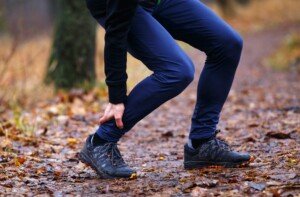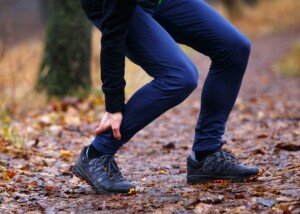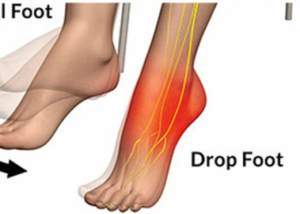When you least expect it your ankle can “catch” on something and roll out, getting sprained.
Here’s how to strengthen your ankles whether you walk or jog.
“While all ankle sprains certainly can’t be avoided, there are things that you can do to help decrease your chances of injury,” says Dr. Megan McLain, PT, DPT, cofounder of Intuitive Choice Physical Therapy & Wellness in Atlanta, GA.
“For starters, you can to make sure that you are completing strength training, especially for the muscle groups in your core and legs.
“All of the muscles in your legs have to work together in pre-programmed patterns for running and walking, so making sure that all of the muscles are strong enough to do their job is key.
“Of particular interest are strengthening your glutes and peroneal muscles (ones that run on the outside of the calf that you can feel activate when you flex your ankle outward).
“These help to stabilize your ankle if you stumble into a position where you could roll your ankle.”
And those positions can come when you least expect them.
For example, one time I stepped over a barrier at a ping pong club, not knowing that on the other side, right up against the barrier, was a ping pong ball.
The very edge of the side of my foot came down on it – and my ankle almost rolled. It was a close call!
It’s possible that the roll didn’t unfold because my ankle ligaments are strong.
When one is walking outdoors, they may inadvertently step on a little stone which causes an ankle roll-out.
The ankle is in contact longer with the stone than if the person were jogging, and thus there’s more time for a roll to occur.
Below are various exercises recommended by Dr. McLain to make the ankle more durable and resistant to rolling out.
- Long sitting banded ankle eversion (beginner)
- Heel raises (beginner)
- Side-lying hip abduction (beginner)
- Sidestepping with band on feet (intermediate)
- Single leg activities like single leg balance, Romanian deadlifts (advanced)
- Skater jumps (advanced-plyometric)
Ankle Eversion
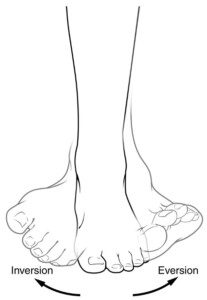
Ankle Eversion. Connexions/CC 3.0/creativecommons.org/licenses/Wikimedia Commons
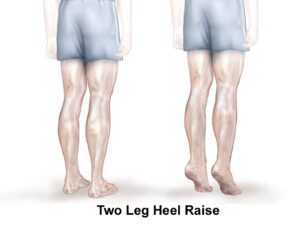
Heel Raise. BruceBlaus/CC BY-SA 4.0/creativecommons.org/licenses/by-sa/4.0/via Wikimedia Commons

Side-lying hip abduction/leg raise. Freepik.com/Racool_studio

Sidestepping with a tension band. Freepik.com/Karlyukav

Single leg balancing. Saidel
Dr. McLain also explains, “Work on ankle proprioception. Our sense of proprioception (how you can tell where your foot is at in space) is gained through our sensory nerves, which is how you can feel how your foot is contacting the ground.
“It also comes from sensory information about the level of stretch in the ligaments of the foot.
“Since an ankle sprain affects the ligaments, this sense can be compromised, since it is highly dependent on our ligaments being intact.
“You can work on proprioception by balancing on foam surfaces, walking on uneven surfaces or balancing on one leg throwing a ball against a wall.”
For example, you may want to try what’s sometimes called rough walking: Walking on lumpy, uneven trails near your home, or across fields of grass.
Always watch where you’re going, of course, so you don’t end up stepping on a rock or in a small hole which can twist your ankle.
If you use a treadmill, do NOT hold on. This deactivates your body’s balancing system and makes it easier for the ankles to keep up with the tread – and ankles won’t get stronger if they’re coddled.
“Make sure that any prior injuries are rehabbed well before jumping back into activity,” says Dr. McLain.
“Once you have one ankle sprain, you are at increased risk for another one, so make sure that you have a guided rehab program and pass sports-specific testing.
“Use ankle braces during high impact activity if you have had repeated sprains in order to protect from further injury. This is not to be seen as a substitute for developing strong ankles.”
Walking Backwards to Strengthen the Ankles
Slowly walking backwards on the balls of your feet, including with feet pointed inward and outward, is another way to toughen up the ligaments of the ankles.
This can be done anywhere where there’s not a risk of stumbling, such as up and down your driveway or a hallway in your house.
This can also be done on a treadmill – but holding on will defeat the purpose. Start out SLOW, perhaps 1 mph, so you don’t feel a need to hold on.
Walking backwards on a treadmill without holding on will force good posture, and the novel challenge to your ankles will encourage improvement in durability.
 Dr. Megan McLain, PT, DPT, puts her clients first while providing one-on-one in-home care. With physical therapy and health coaching services, Dr. McLain addresses all aspects such as physical barriers, mindset, accountability and knowledge that may be impacting the client’s experience.
Dr. Megan McLain, PT, DPT, puts her clients first while providing one-on-one in-home care. With physical therapy and health coaching services, Dr. McLain addresses all aspects such as physical barriers, mindset, accountability and knowledge that may be impacting the client’s experience.
 Lorra Garrick has been covering medical, fitness and cybersecurity topics for many years, having written thousands of articles for print magazines and websites, including as a ghostwriter. She’s also a former ACE-certified personal trainer.
Lorra Garrick has been covering medical, fitness and cybersecurity topics for many years, having written thousands of articles for print magazines and websites, including as a ghostwriter. She’s also a former ACE-certified personal trainer.
.

